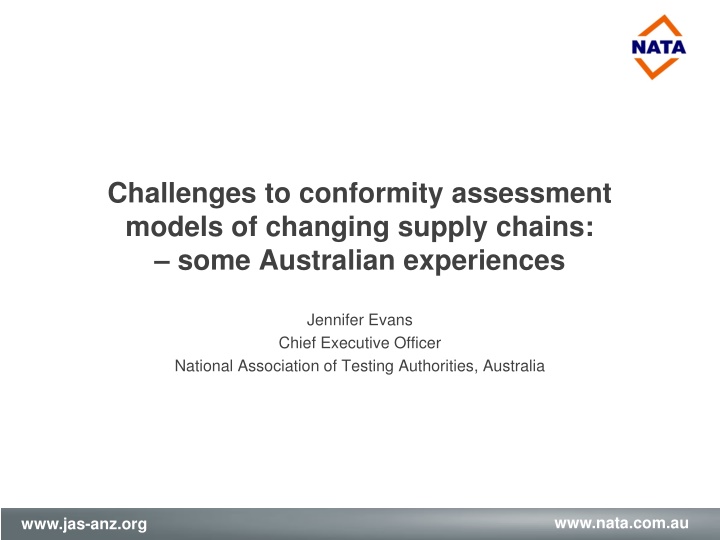
Australian Experiences with Changing Supply Chains: Challenges in Conformity Assessment Models
Explore how changing supply chains have impacted Australia's economy, challenges in conformity assessment procedures, risks from poor transparency, and benefits of surveillance testing. Learn about assumptions in supply chains, the evolution of supply chains in Australia, and characteristics of the old and modern economies.
Download Presentation

Please find below an Image/Link to download the presentation.
The content on the website is provided AS IS for your information and personal use only. It may not be sold, licensed, or shared on other websites without obtaining consent from the author. If you encounter any issues during the download, it is possible that the publisher has removed the file from their server.
You are allowed to download the files provided on this website for personal or commercial use, subject to the condition that they are used lawfully. All files are the property of their respective owners.
The content on the website is provided AS IS for your information and personal use only. It may not be sold, licensed, or shared on other websites without obtaining consent from the author.
E N D
Presentation Transcript
Challenges to conformity assessment models of changing supply chains: some Australian experiences Jennifer Evans Chief Executive Officer National Association of Testing Authorities, Australia www.nata.com.au www.jas-anz.org
Overview How changing supply chains have impacted on areas of Australia s economy Changes in conformity assessment infrastructure Risks introduced from poor transparency and information asymmetries Challenges to conformity assessment procedures of undesirable market outcomes Example of where surveillance testing can benefit the market. www.nata.com.au www.jas-anz.org
Assumptions about supply chains 1. Transparency if there are questions relating to the goods conformity with requirements or specifications, answers can be obtained in a reasonable timeframe. 2. Behaviour all players in a supply chain behave with an acceptable level of fairness and integrity. www.nata.com.au www.jas-anz.org
Supply Chains Then and Now Until 1980s, Australia s economy: Significant manufacturing sector making a broad range of products Imports subject to protection including tariffs on imported goods Conformity assessment in regulated sectors performed by government laboratories or by private sector laboratories which were NATA accredited Imported goods subjected to conformity assessment in Australia NATA s laboratory accreditations reflected the makeup of the economy Certification largely restricted to approval by regulators No systems of management system certification www.nata.com.au www.jas-anz.org
Characteristics of the old economy Local raw materials components finished product wholesalers retailers Product traceability was straightforward Most risk could be managed by the manufacturer. Regulatory oversight was straightforward The conformity assessment was generally at two points the suitability of raw materials and the finished product www.nata.com.au www.jas-anz.org
Characteristics of modern supply networks Often complex transnational , multiple suppliers of raw materials/components and final assembly plants Dynamic frequent changes to parts of the supply network that are not visible to downstream players Traceability of supply network challenging for goods that are not uniquely identifiable If goods are non-conforming with requirements, may be difficult to identify source of fault Poor management of network may lead to diffusion of responsibility/ lack of accountability www.nata.com.au www.jas-anz.org
Product attributes Search attributes what can be observed by an end user Experience attributes - features that can be readily identified after consumption or use Credence attributes - claims about characteristics which cannot reasonably be checked by end users even through use or experience www.nata.com.au www.jas-anz.org
An example from the Australian economy - construction Significant proportion of materials and products are imported Less local testing, international standards and new products and materials Extensive deregulation - move from prescriptive requirements to a performance-based, government to private sector Testing and certification still relevant but greater role for other expertise: e.g. private sector engineering consultants and building surveyors Knowledge of credence attributes more difficult to ascertain/ more important to evaluate www.nata.com.au www.jas-anz.org
Non-conforming product Growing number of instances of non-compliant materials found in major construction works Structural fasteners Cladding Cabling Extremely bad media where products and materials have been demonstrated to be non-conforming particularly safety-related Materials containing asbestos Cement Structural plywood Conformity assessment being questioned Regulatory regimes questioned Imports blamed www.nata.com.au www.jas-anz.org
What is the problem/are there solutions? Construction industry issue has not led to any trade dispute .. yet Public frustration and (unfair) distrust of imports Some in industry calling for on-shore testing and certification of all imported materials and products not a solution! Appropriate conformity assessment procedures, a reliable conformity assessment infrastructure and clear standards are critical National quality infrastructure cannot compensate for lack of transparency, fairness and integrity in supply networks Hence, can regulatory policy be adjusted to encourage supply chains to do the right thing? www.nata.com.au www.jas-anz.org
Incentives One example that drives behaviour Australian energy efficiency program for electrical equipment and appliances - E3 Program administered by federal government Conformity assessment procedures give latitude to pre-market measures but place emphasis on post-market check-testing at accredited laboratories Check-testing targeted risk, supplier history, whistle-blowers Penalties can include fines and product recalls www.nata.com.au www.jas-anz.org
Summary Regulatory authority/NQI dialogue can help avoid trade disputation ILAC and IAF can facilitate mutual recognition of conformity assessments Where national standards/ unique requirements exist, accreditation may be supplemented with means of mutual education Where international standards form the basis for conformity assessment, accreditation for testing, inspection and certification activities can be highly effective Majority of goods imported into Australia, and those we export do meet business and consumer expectations. Conclusion - It is working but we can always improve www.nata.com.au www.jas-anz.org
References Supply chains/networks C Harland, R Brenchley, H Walker, Risk in supply networks, Journal of Purchasing and Supply Management 9 (2003) D O Brien, Towards a quantitative risk analysis framework to identify Non- Conforming Building Products. Journal of Building Surveying, Appraisal and Valuation Henry Stewart, London. Volume 5, No.4. (2017) E3 Program for energy efficiency http://www.energyrating.gov.au/about www.nata.com.au www.jas-anz.org
